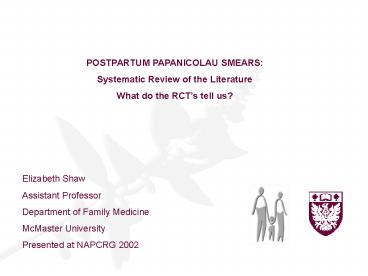POSTPARTUM PAPANICOLAU SMEARS: - PowerPoint PPT Presentation
1 / 15
Title:
POSTPARTUM PAPANICOLAU SMEARS:
Description:
Cheryl Levitt, Liz Shaw, Janusz Kaczorowski, Sharon Brownlee, Russ Springate, ... postpartum medical disorders: UTIs, haemorrhoids, constipation, weight loss. Anemia ... – PowerPoint PPT presentation
Number of Views:54
Avg rating:3.0/5.0
Title: POSTPARTUM PAPANICOLAU SMEARS:
1
POSTPARTUM PAPANICOLAU SMEARS Systematic
Review of the Literature What do the RCTs tell
us? Elizabeth Shaw Assistant
Professor Department of Family Medicine McMaster
University Presented at NAPCRG 2002
2
(No Transcript)
3
(No Transcript)
4
Credit to my colleagues The Evidence-Based
Postpartum Research Group Cheryl Levitt, Liz
Shaw, Janusz Kaczorowski, Sharon Brownlee, Russ
Springate, Murray Enkin, John Sellors, Barbara
Stroskopf, Maria Patriquin Supported by a grant
from the Bureau for Reproductive and Child
Health-Health Canada
5
RESULTS
671 studies
140 Articles
Sorted by Topic
66 Articles Other
33 Articles Perineal Pain
41 Articles Breastfeeding
63 Articles
Consensus Reached for Clinical Relevance
6
- 63 other
- pap smear
- rubella immunization
- contraception
- postpartum support
- early discharge
- postpartum depression and anxiety
- postpartum medical disorders UTIs,
haemorrhoids, constipation, weight loss. Anemia - smoking cessation
- nutritional supplements (other than BF)
- effects of pelvic floor exercises
- effect of early newborn contact
7
INTRODUCTION
- Pap screening has reduced deaths due to cervical
cancer - Postpartum period-ideal for opportunistic
screening - Tradition-Pap at 6 weeks PP ?
8
SEARCH RESULTS
- Only one RCT met our inclusion criteria
- Addressed the timing of the PP Pap smear
9
METHODOLOGIC QUALITY
- Assessed using the JADAD scale
- Assigns points for randomization, blinding, and
description of drop-outs - Scored 2/5
- Randomization process unclear
- Only pathologists were blinded (however not
overall a detriment to quality) - PLUS
- Intention to treat
- A priori power calculation
10
CLINICAL QUESTION?
- Does the timing of the postpartum Pap smear
influence the proportion of dysplastic and
non-dysplastic abnormal results requiring further
follow-up?
11
RESULTS
- 184 women randomized to Pap at 4, 6 or 8 weeks
- Any abnormal smear was followed up at 3 months
- all smears were adequate
12
RESULTS
13
RESULTS
- Difference in abnormal smears between 4,6 and 8
weeks was significant (p.36) - Odds of having a normal Pap
- 6 weeks 2.27 (1.39-3.75)
- 8 weeks 5.20 (1.92-14.07)
- ?50 of the study group failed to show for their
3 month follow-up
14
DISCUSSION
- ? Classification system
- Inflammatory-normal in the Bethesda system
- How many would need to be repeated?
- No difference in atypia or CIN (small
numbers) - How many of these smears were necessary in the
first place?
15
CONCLUSION
- Delaying the postpartum Pap smear until 8 weeks
reduces the number of inflammatory smears - It is unclear if this reduces the number of
smears that require further follow-up - Should low-risk women who are screened regularly
have a PP pap at all?


























![Read [PDF] Down Came the Rain: My Journey Through Postpartum Depressio PowerPoint PPT Presentation](https://s3.amazonaws.com/images.powershow.com/10068597.th0.jpg?_=20240703041)




